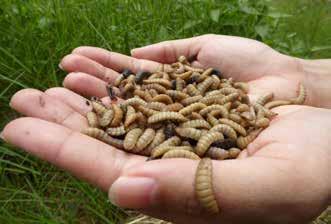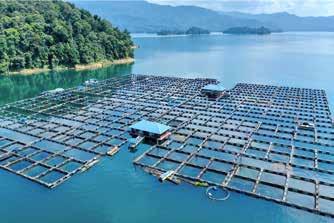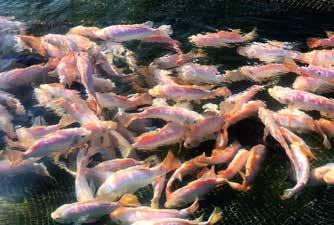
12 minute read
Advances in fish meal and fish oil replacements
Production and technology development of insect proteins and soy based raw materials
The F3 Challenge began a series of webinars in 2021 bringing together groups of producers of alternative ingredients to replace fish meal and fish oil. In February, it was Insects in Aquafeeds: Progress towards fish meal/ fish oil substitution. In the follow-up webinar in March, it was the turn of producers of soy based raw materials. The third webinar in April featured innovators of singlecell and novel proteins for aquafeeds and in the fourth in May, algae and seed oil manufacturers will discuss latest research, and fish oil replacement successes for their products. Reports on the latter two webinars will be published in issue July/August 2021.
The moderator was Professor Kevin Fitzsimmons, Chair of the F3 Challenge and Judge, Professor and Director of International Programs at The University of Arizona, USA. Future of Fish Feed (F3) is a collaborative effort between NGOs, researchers, and private partnerships to accelerate the commercialisation of innovative, substitute aquaculture feed ingredients to replace wild-caught fish.
Black soldier fly larvae. Picture credit: Nutrition Technologies
Insects in aquafeeds
Fitzsimmons introduced six major insect protein producers from the US, China, Southeast Asia and Europe. US based Chapul Farms is a current contestant in the F3 challenge, carnivore edition, salmonid category. Chapul Farms was started 9 years ago. It works with the black soldier fly, Hermetia illucens (BSF) and is building and scaling modular insect farms. There are seven projects in development.
Patrick Crowley, CEO said, “Our strategy is a low variability feed stock as the starting point of our systems design. However, a crucial element of project development is offtake from the farms. We focus primarily on BSF in aquafeeds. In terms of trials, there are numerous academic studies, even up to 100% replacement fish meal, demonstrating at least no negative growth factors.
“We are seeing price limiting inclusion rates more than nutrition itself. We are also seeing some of the immunological stress tolerance benefits of the BSF even at lower inclusion rates,” added Crowley. Guangzhou FishTech Biotechnology is in insect meal production since 2009 working on the BSF. Production capacity is >10,000 tonnes which can be easily expanded. It wants to build up insect meal production in China. The company has various types of BSF products such as hydrolysed insect peptides. Numerous application research for BSF in aquafeeds have been conducted such as with the vannamei shrimp, Japanese seabass, hybrid snakehead, largemouth bass, etc.
Dr Wingwang Lu, CEO emphasised the functional value of BSF. “BSF can replace a certain level of fish meal in different aquatic species without affecting growth, but the amount will vary with species. There is a strong growth-promoting effect too. BSF could replace squid and fish paste and other attractants to improve palatability. There is an immunity effect such as improving the survival rate of fish and shrimp and disease resistance.”
Nutrition Technologies, founded in 2015, is Southeast Asia’s leading insect meal producer. Nick Piggott, CEO and Co-Founder, said, “Southeast Asia offers vast access to agro-industrial by products and the ideal climate for BSF larvae production.” After extensive R&D, Nutrition Technologies opened its first factory in March 2018 in Malaysia. Here, it is ramping up its industrial scale facilities. “Our long-term objective is to produce a sustainable and staple ingredient for the feed industry which can compete with fish meal and soybean meals.”
The company has pioneered a new and more efficient insect rearing process using its own bacterial inoculants. “In order to offer high quality, sustainable and competitively priced products, our research and innovation team is actively pushing the boundaries conducting trials for and with customers while testing new formulas and ingredients,” said Tom Berry, Co-Founder. Future expansion plans are to Thailand, Vietnam and Indonesia.
Kees Aarts, Founder and CEO, set up the award-winning Protix in the Netherlands in 2009. In the last couple of years, the trend is towards innovative products and system changing with reduced production footprint. “At Protix, for every kg of protein we produce, we can reduce well over 4kg of CO2 out of these systems as well as reducing land and water use by 80 to 90%. At our world class flagship facility in Bergen op Zoom, we are already producing beyond design capacity. Protix recently introduced an improved strain of insect that is fast improving production.”
Aarts gave three main reasons for insect meals in aquafeeds. Composition and quality where insect meals have suitable amino acid and fatty acid profiles, high digestibility as well as high palatability. Inclusion levels at 20-60% have successfully replaced dietary proteins and helped promote liver and gut health and immune response modulation. “The body of evidence in peer reviewed scientific publications are mounting. We are committed to mass adoption of insect based nutrition.” A recent article showed improved antioxidant activity of BSF proteins. Insect based proteins have proven themselves in terms of productivity and
bioactivity. “The Protix derisked technology platform with 100% production capacity allows for rapid rollout and volume expansion,” added Aarts.
In 2018, InnovaFeed, based in France launched its insect meal (BSF) ingredient ProtiNova with an amino acid profile close to fish meal for salmonids. At the R&D level, 100% of fish meal was replaced for the salmonids and tilapia. “Beyond R&D, we have included the insect meal in commercial feeds for trout and salmon. Trout fed with insects are commercialised in a supermarket chain across France,” said Maye Walraven, Head of Business Development. In 2021, it launched a shrimp ingredient Nova Gain, which can improve FCR by 30% and growth by 20% and resistance to several diseases (see article on pages 49). InnovaFeed is in the process of adding this into commercial feeds.
Since 2020, InnovaFeed has launched a full scale industrial plant. By co-locating with a starch plant, it has a unique symbiosis model and is pioneering sustainability with 57,000 tonnes of saved CO2 per year. “LCA of InnovaFeed’s insect meal products show environmental performance. For ProtiNova, kg CO2 eq is -55% less than fish meal and 3 tonnes of forage fish is saved per tonne of insect meal.” It will replicate this concept across several plants around the world. A new plant in Decatur, Illinois, USA will be next to an ADM plant. By 2030, InnovaFeed plans to produce between 300,000 to 500,000 tonnes of insect proteins for the aquaculture market.
Ynsect, France with USD 372 million series C funding, uses wheat husk, corn husk and derivatives of cereals as feed substrates. There are two factories in France, the first produces 1,000 tonnes and a second plant will produce 100,000 tonnes/year.
Alain Revah, Chief Marketing and Strategy Officer, said, “We have been publishing extensively research results, showing the performance of our insect protein, increasing yields by 35% and decreasing mortality by 40%.” On replacing fish meal with insect proteins, Revah said, “Today I do not think that completely replacing fish meal will occur. We can be complementary to fish meal and fish oil. We can reduce the stress on fish stocks. But if aquaculture farmers want to, our ingredients can be used to completely replace fish meal.
“Regulatory wise in the European Union, we can use our protein to feed fish and shrimp. We just received a favourable notice from the EFSA to use Artenaria molitor protein for human food. We also expect some decision on poultry feeds and wish to see some regulatory approval for the US markets for aquaculture and petfood market.”
Revah added that Ynsect is the highest in rank in terms of sustainability with its circular economy. It has a carbon negative plant, as it sequesters more carbon than it emits. In 3 years, Ynsect will have the world’s largest plant as well as a second plant in the US.

Image credit: USSEC
Soy ingredients in aquafeeds
Six major producers of soy products for aquafeeds presented on the latest progress in developing new products. The role of USSEC or US Soy Export Council is to optimise utilisation and value of US soy in feed, aquaculture and human consumption in international markets. Lukas Manomaitis, Aquaculture Program Technical Contractor said that soy is well established as a replacement for fish meal. Product developments have progressed from low 45-50% crude protein (CP) soybean meal (SBM) to soy protein concentrates (SPCs) of 50-70% CP with removal of anti-nutritional factors. “As we move away from fish meal and fish oil, we have a variety of products, but we need to understand the ingredients, their specific nutrients and strengths.”
As part of the work with industry, USSEC worked with collaborators to develop an alternative database (www.IAFFD.com), specifically to fill a need since many commercial databases, though available, are not comprehensive enough for aquafeed formulation work. Manomaitis encouraged commercial feeds formulators to use this database, as an addition to the existing database in the factory or for benchmarking to improve their formulations.
Jiangsu Fuhai Biotech Co., Ltd currently has 200 tonnes of products and expects to scale up to 15,000 tonnes annually by 2025. The company has two products: 38%CP SBM and SBM with 48% CP. Zhijun Hu, CEO showed that the enzyme treated SBM could replace Peruvian fish meal in 42% CP vannamei shrimp diets with no significant effects on weight gain as compared to a fish meal diet. There was better survival and mitigation against WSSV. Similarly, the enzyme treated SBM could replace 15% fish meal in feeds for yellow head catfish and large mouth seabass. He concluded that the price can be less than Peruvian fish meal and that with scaling up, this can be further lowered. Funding can accelerate production.
Benson Hill Bio-Systems uses artificial intelligence (AI), data and a variety of breeding techniques to create innovative food and ingredient products. It is one of the top companies funded by AgFunder. It has developed a non-GMO, “ultra-high” protein soybean with ultra-low oligosaccharide (HPULO). The crop was grown in 2020 and is currently being processed as SBM. Hannah Lucas, Business Development Manager showed how the meal has 48-51.5% CP, depending on the process.
HPULO is highly digestible in rainbow trout at 89% for protein digestibility. Benson Hill has tested the meal in several species-salmon, trout, yellow tail, vannamei shrimp and cobia. “There was no evidence of enteritis in salmon or trout. Diets with HPULO outperforms diets with fish meal. With this product, we show LCA to enable sustainable farming and new aquaculture value models.”
Taiwan based DaBomb Protein Corp. has a functional peptide product where the annual production is 36,000 tonnes in Taiwan. DaBomb also produces 12,000 tonnes of functional peptide plus probiotic in Fujian, China for the domestic market. The company expects to produce 72,000 tonnes of products by 2024. Jeffery Jiang, Manager, Agribusiness Unit said, "This 51% CP functional peptide, has high protein digestibility, improves gut health and enhances immunity. Trial data showed no adverse effects on growth with replacement of 15-30% fish meal in diets for the green grouper and Asian seabass and up to 75% in low fish meal diets for the vannamei shrimp. Immunity was also studied and results indicated that our functional peptide could induce an immune response.” Jiang added that, as the raw material is SBM, with rising prices, the company now faces competitive issues, such as the price gap with other materials, in particular fish meal.
US based Menon Renewable Products, Inc. utilises agriculture wastes as inputs to create a functional peptide called Mr Feed. The company has a production capacity that can support 500,000 tonnes of finished feeds and will be able to upscale to provide for one million tonnes of aquafeeds in 3 years. The peptides are less than 1kDa. “Mr Feed is being used successfully in more than 15 countries. With the vannamei shrimp, trials in 7 markets showed 40% better survival and better protection against early mortality syndrome, white faeces disease and white spot syndrome virus. In trout, snapper and tilapia, the growth improved by 30%, survival by 9% and there was a 40% reduction in parasites,” said Dr Suresh M. Menon, Founder and CEO.
With 37 years in the industry, CJ Selecta now produces one million tonnes annually and is the largest producer of soy protein concentrate (SPC). SPC is produced via aqueous alcohol extraction of defatted soy flakes. “SPC with 65% CP is a fish meal replacer in salmon diets. Digestibility is high at 90%,” said Dr Patricia Sugui, Sustainability Manager. She showed that the product X-Soy 600 had a digestibility coefficient as high as 93% in shrimp and fish. CJ selecta also has a micronised SPC, with a particle size of 180µm. “In response to current socio-environmental concerns around Brazil’s soy industry and the growing demand for sustainable products, the company has implemented sustainable actions. We improved our traceability, using only certified GMO and non-GMO soybeans and reduced carbon footprint of SPC. We ensure than our purchases are free from deforestation and social issues.”
Malaysian Fish Farm for Sale

Located in beautiful clean waters in Tasek Kenyir, Terengganu, this technologically advanced business is now up for sale as a going concern, complete with everything needed to function from day 1 of acquisition.
The fish farm is well known for the production of the finest quality Tilapia, pangasius, Baung (Bagridae), Jelawat (sultan fish or Leptobarbus hoevenii) and other local Malaysian species.
Exclusively with the Department of Fisheries, Aquaculture Zone in Kenyir lake and surrounded by protected National Park the farm boasts one of the most stunning scenic locations to work from. Situated about 25 minutes from Kuala Berang and 45 minutes Kuala Terengganu, Terengganu, it is ideally located for markets, distribution network and amenities.
With the capital city of Kuala Lumpur just 5 hours drive from the farm and motorway network serving most of the trans peninsula area and with a custom fitted live fish transportation lorry, the farm can move large volumes of live and chilled fish and dry goods back and forth across the peninsula with relative ease. More details, email: info@ sgcomofarms.com/Margaret@sgcomofarms.com






